Organikum
resurrected
    
Posts: 2329
Registered: 12-10-2002
Location: Europe
Member Is Offline
Mood: busy and in love
|
|
photochemistry
The setup of some experiments for determining the influence of UV on certain reactions:
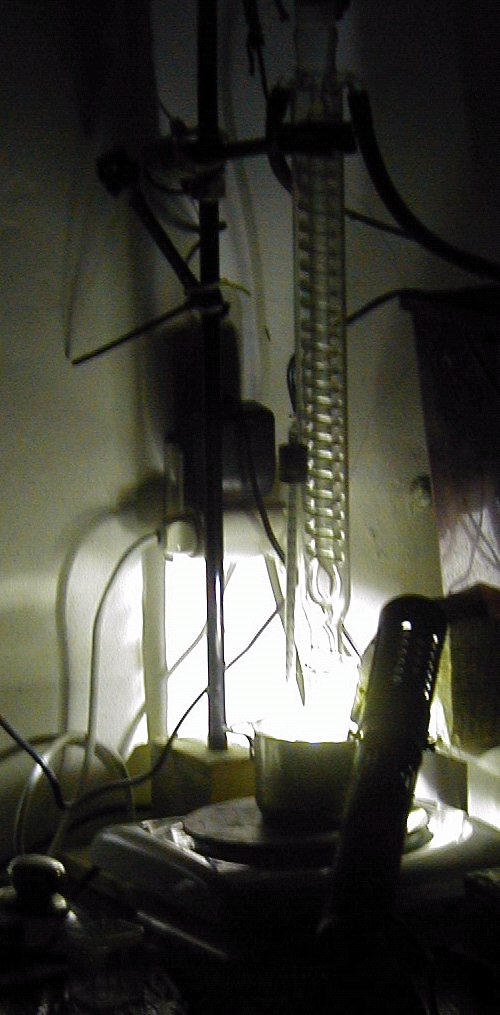
A 50W Hg-UV lamp was used as seen.
Its a nice pic I believe, so I thought I share it.

[Edited on 12-2-2004 by Organikum]
|
|
|
vulture
Forum Gatekeeper
    
Posts: 3330
Registered: 25-5-2002
Location: France
Member Is Offline
Mood: No Mood
|
|
Where did you get the UV lamp? Hg-vapor is usually bloody expensive.
My wet dream is a Hg vapor light that'll fit down a NS14.
One shouldn't accept or resort to the mutilation of science to appease the mentally impaired.
|
|
|
Organikum
resurrected
    
Posts: 2329
Registered: 12-10-2002
Location: Europe
Member Is Offline
Mood: busy and in love
|
|
From a friend who was working in a porcelain factory - it was used to check the glaze/colors. It was thrown away and he dunbsterdived it - together
with a Mettler-Toledo Metarange electronic scale.
Both is lost to me now - shit happens.
|
|
|
MnkyBoy
Harmless

Posts: 8
Registered: 30-3-2003
Member Is Offline
Mood: constipated
|
|
I must find the pics of a simular set up I had going, except inplace of the lamp I had two carbon electrodes with a small gap between them and the arc
was powered by a arc welder. Both the rxn vessel and the spark gap were housed inside a plexiglass box with a slow steady flow of N2 keeping the box
void of atmospheric air.
|
|
|
agp123
Harmless

Posts: 2
Registered: 8-6-2006
Member Is Offline
Mood: No Mood
|
|
Pl send detail of detail on photochlorination
|
|
|
quantumcorespacealchemyst
Banned Shitposter
Posts: 213
Registered: 17-10-2014
Member Is Offline
Mood: No Mood
|
|
a 27ish mm quartz tube, with a dome on one end, with a magnetic stirrer and a small 12v UV lamp that runs on two 6v lantern batteries in series, using
an aluminum foil reflector housing, running on a mixture of super fine copper powder and iodine powder from grinding crystals, in water from
distillation affords a pure white powder, seemingly copper i iodide, CuI, which precipitates out of solution rather efficiently. settling in layers if
recollection is correct.
prior approach using electrolysis is unsuccessful with same 2x6v series lantern batteries running for a night and day or so.
[Edited on 29-10-2014 by quantumcorespacealchemyst]
|
|
|
IrC
International Hazard
    
Posts: 2710
Registered: 7-3-2005
Location: Eureka
Member Is Offline
Mood: Discovering
|
|
10W UV LED high power led lamp light 390-405nm 70Lm
http://www.ebay.com/itm/10W-UV-LED-high-power-led-lamp-light...
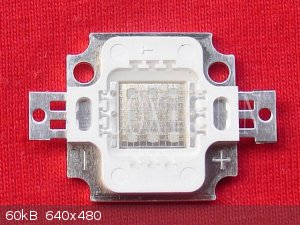
Does anyone have an opinion of how well this uV source would work? Draws 900 ma at 12 volts.
"Science is the belief in the ignorance of the experts" Richard Feynman
|
|
|
careysub
International Hazard
    
Posts: 1339
Registered: 4-8-2014
Location: Coastal Sage Scrub Biome
Member Is Offline
Mood: Lowest quantum state
|
|
Quote: Originally posted by IrC  | 10W UV LED high power led lamp light 390-405nm 70Lm
...
Does anyone have an opinion of how well this uV source would work? Draws 900 ma at 12 volts.
|
The photon efficiency per watt should be high, but LEDs only put out near-UV light. Sunlight UV goes up to about 300 nm (where ozone layer
transmittance blocks it), germicidal mercury lights emit at the DNA-scrambling wavelength of 254 nm.
I don't know what wavelengths are most often needed in photochemistry, but I would guess that higher energies (shorter wavelengths) are usually
better.
|
|
|
BromicAcid
International Hazard
    
Posts: 3227
Registered: 13-7-2003
Location: Wisconsin
Member Is Offline
Mood: Rock n' Roll
|
|
Wavelengths needed can be calculated by the bond energy of the bond you are trying to break. There is a good example available here:
alpha.chem.umb.edu/chemistry/ch471/documents/PS3Solution.pdf
Here is a relevant bit: | Quote: | The average bond dissociation energies of C-F, C-Cl, C-Br and C-I are 473, 347, 293 and 238 kJ mol-1, respectively.
Recalling the simple relationship, E= hν, we can calculate the energy required to break a single bond in each of these species. Important: the energy
of the photon only has to break one bond, not a mole of bonds!
For C-F, 473 kJ/mol = 7.85x10-19 J/photon
E = hν = hc/λ
λ= hc/E
λ = (6.626x10-34 J sec)(3.00x108m/sec)/ 8.04x10-19 J/photon
λ= 2.53x10-7 m = 253 nm
For C-Cl, λ = 345 nm, for C-Br, λ = 408 nm, and for C-I, λ = 503 nm. |
|
|
|
IrC
International Hazard
    
Posts: 2710
Registered: 7-3-2005
Location: Eureka
Member Is Offline
Mood: Discovering
|
|
Thanks Bromic but you prompt me to ask yet another question. Hopefully not too lame as you know electronics not chemistry is my main area of study.
Can I assume this is not like the photoelectric effect in frequency terms, meaning so long as the photons are of a frequency higher than needed to
break the bond will it work? I conclude from your post my 10W Led at 390 to 405 nm will break Carbon Bromine or Carbon Iodine bonds but not Carbon
Chlorine. So if I had say a 245 nm source it would break all three? My confusion stems from wondering if the source has to be at the frequency
required to match the bond energy or merely more energetic. If I had this:
UV-C 254nm Germicidal 125mm L-shape Lamp Bulb 12V DC Kit
http://www.ebay.com/itm/UV-C-254nm-Germicidal-125mm-L-shape-...
would it work for all three? Or do bonds require frequency specific light to break them as opposed to merely having photons of higher energy than that
of the bond?
Stated uV output is Max. 5.0mW/cm2, so far less output than the 70 lm Led is a problem, but as you said each bond only needs one photon of high enough
energy to break it. So maybe this gas type light would be adequate for small scale experiments?
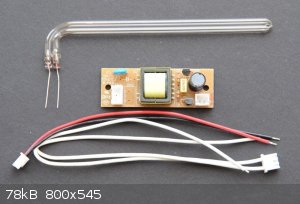
"Science is the belief in the ignorance of the experts" Richard Feynman
|
|
|
BromicAcid
International Hazard
    
Posts: 3227
Registered: 13-7-2003
Location: Wisconsin
Member Is Offline
Mood: Rock n' Roll
|
|
Yes, at 245 nm you would be breaking all three types of bonds. It's not a matter of resonance or matching up with the wavelength but just the energy
contained within the photon.
|
|
|
IrC
International Hazard
    
Posts: 2710
Registered: 7-3-2005
Location: Eureka
Member Is Offline
Mood: Discovering
|
|
So assuming the photon is of higher energy than required is the remaining converted into vibration (the difference transferring momentum to the atoms
or molecules)? Since as you say this is not a quantum effect, I would have trouble believing the excess energy went into a photon of the difference
energy in frequency. I surmise it must be more a purely mechanical effect with the photons momentum. If so then if one desired to reduce heating
effects would it not make sense to use the correct frequency (no higher) for the desired bond breaking? Seems this could be also used to break only
certain bonds. Say a carbon ring or chain with all three halogens mentioned could be selectively reacted within limits. Say we only wanted to remove
the Iodine so we chose a spectrally pure 503 nm source? Of course then we would have trouble with the Cl or Br since the light to break these would
also break any bonds requiring lower energy. If we wanted to remove I and Br yet leave the Cl we could use a pure 408 nm source. Just pondering out
loud, wondering if in certain circumstances advantage could be taken of the effect.
"Science is the belief in the ignorance of the experts" Richard Feynman
|
|
|
careysub
International Hazard
    
Posts: 1339
Registered: 4-8-2014
Location: Coastal Sage Scrub Biome
Member Is Offline
Mood: Lowest quantum state
|
|
Lasers are employed for selective excitement of chemical reactions.
You can find material on this with search engines.
|
|
|
IrC
International Hazard
    
Posts: 2710
Registered: 7-3-2005
Location: Eureka
Member Is Offline
Mood: Discovering
|
|
Probably so but then I would not hear what Bromic has to say about it and I respect his opinion far more than random sources from the internet. Even
though I have a tunable dye laser setup sitting in a box somewhere as well as many dyes, I'm not really inclined to toy with the reactions, more of a
curiosity thing for me.
Rob you wrote a book a while ago which used to be on your site. Where did it go? Not talking about the chemistry book.
"Science is the belief in the ignorance of the experts" Richard Feynman
|
|
|
quantumcorespacealchemyst
Banned Shitposter
Posts: 213
Registered: 17-10-2014
Member Is Offline
Mood: No Mood
|
|
selenic acid by UV exitation of selenium in hydrogen peroxide
Irc, that lamp you posted is the type* that i used to make CuI
copper powder, iodine powder water and that light seem to produce copper (I) iodide, CuI
*~the small squat double version with leads on both sides http://www.ebay.com/itm/321437432790?_trksid=p2060778.m2749....
~the version pictured above with the wrap around shape seems to be more appropriate as it can be put in reactive solutions without the plastic and
leads being eaten.
http://www.ebay.com/itm/321437432790?_trksid=p2060778.m2749....
I am currently testing it on black selenium powder in old H2O2.
i read that selenium oxide is produced by selenium metal in H2O2 and also that selenic acid is produced from selenium oxide in H2O2.
the H2O2 was bough about half a year ago i guess (but has no date on it besides a copyright of 2012, hope that is not the production date, or rather,
i hope it is so i know what is going on?) and doesn't seem to turn my skin white. ecover 30% H2O2 used to and it was seemingly at least 3 months old
when i used it in synthesis some years ago. this stuff is slightly bubbling when i dumped alot more in the vessel.
now it is on a hotplate, stirring, and with seemingly no effect besides the bubbling, is being step wise (with plateaus to get an idea of effects)
heated towards 83-100 degrees celcius.
the bubbles seem to me to mean that instead of reacting, the selenium is catalyzing the H2O2 decomposition and heating it is only going to hasten
that, hopefully it gets enough energy to the selenium combined with the UV light to effect a reaction.
i have yet to try fresh H2O2 and/or a stronger UV light source yet and am thinking i need to start small scale, micromacro? production of it.
someone please help me figure out why this route to selenic acid (and oxide) is not working. this route is seemingly the purest way to arrive at
selenic acid.
i am going to start a selenic acid thread as i have found not much information about it.
[Edited on 20-11-2014 by quantumcorespacealchemyst]
|
|
|
quantumcorespacealchemyst
Banned Shitposter
Posts: 213
Registered: 17-10-2014
Member Is Offline
Mood: No Mood
|
|
It changed color
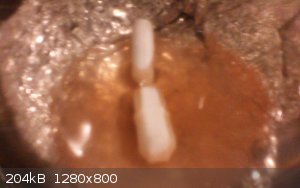 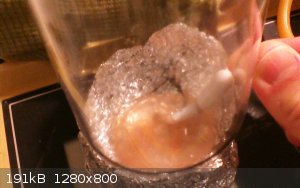
|
|
|
smaerd
International Hazard
    
Posts: 1262
Registered: 23-1-2010
Member Is Offline
Mood: hmm...
|
|
Guess I should mention this because it may pertain to what you're working on quantumcorespacealchemyst. Singlet oxygen can be generated by the action
of UV light on certain organic dyes in the presence of diatomic oxygen iirc. One common and perhaps the most ubiquitous would be Methylene Blue. I'm
not 100% sure if that's the mechanism you'd be looking for it's pretty late over here but I'll think it through more thuroughly tomorrow.
|
|
|
quantumcorespacealchemyst
Banned Shitposter
Posts: 213
Registered: 17-10-2014
Member Is Offline
Mood: No Mood
|
|
Thank you, that is interesting. I believe I posted the last pictures here by mistake, and meant to put it in the selenic acid thread. I'm glad I
goofed, as I might have otherwise not learned this.
I also found that the copper Iodide seems to act as a catalyst to combine iodine and copper powders in water. I had some partly reacted copper, mixed
with the copper it formed from the iodine with UV light and stirring and added more ground iodine/ground it all together (still an exess of copper)
and put it in a tube with some distilled water. I swirled it around and the water layer turned iodine brown. After letting settle/stand for a few
minutes or so, the water was clear, further swirling and settling being the same.
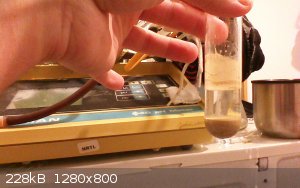
[Edited on 26-1-2015 by quantumcorespacealchemyst]
|
|
|
quantumcorespacealchemyst
Banned Shitposter
Posts: 213
Registered: 17-10-2014
Member Is Offline
Mood: No Mood
|
|
bleach KMnO4 + UV smells sweet. chloramines?hydrazines?
had a box wiped with bleach and some solution of permanganate
mixed a little around and got some HOCl it seemed.
ran UV for a while, different intervals. 5min, 10min 10min again
increasing sweet smell over time.
so i don't know if it's possible HOCl and N2 being reacted by UV light because there was no Ammonia present (this time; HCl salt question in short
answer thread*).
i think something cool was happening though.
had white salt on stuff, puzzled, told was probably HCl salt with NH3. i thought i was out of Ammonia. forgot i had swiezers reagent in a yogurt
container with a poor saran wrap seal that didn't work and when i opened it to see the cool blue color again, i found blue green powder on the bottom,
so the NH3 forming an HCl salt was comprehend able (otherwise i was extremely puzzled).
i almost posted KMNO4 in the Subject.  facepalming facepalming
|
|
|
Texium
|
Thread Moved
22-11-2023 at 19:37 |